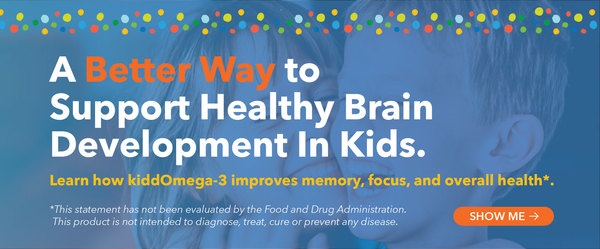
By Dr. Matt Hand
Getting the recommended daily dose of omega-3 is hard enough for adults who dread swallowing large, belch-inducing fish oil pills that you typically find in your local pharmacy.
Kids, who can be even pickier eaters, may prefer to reach for a colorful gummy supplement disguised as a more palatable, sweet treat, rather than a large fish oil pill— but are these colorful, sugary supplements a viable source for omega-3’s? And if not, what should you look for?
What is Omega-3 & Why is it Important?
Omega-3 is one of two major classes of polyunsaturated fatty acids, which also includes omega-6. Both omega-6 and omega-3 are essential fatty acids, which means that your body must obtain them through diet and supplementation.
Omega-6 fats can be found in vegetable oils, corn oils, soybean oils, poultry, and nuts. Due to the shift over the last few decades in most Americans’ diets towards processed and frozen foods, physicians have seen a spike in the recommended 1:1 ratio of omega-6 to omega-3 to 20:1.
Furthermore, studies have shown that excess amounts of dietary omega-6 can activate pro-inflammatory pathways in the body. This dietary imbalance is one of the main reasons why it’s important to identify ways to bring more omega-3s into your supplement routine.
Omega-3 fatty acids can be sourced from fish, particularly anchovies and sardines, as well as plant sources such as nuts, seeds, and algae. While these foods are common, most children in the U.S. rarely eat enough to get adequate quantities of omega-3 in their daily diet. Additionally, the types of fish that most Americans are used to eating such as swordfish, salmon, and tuna are very high in mercury and can pose a risk to health as the concentrations in mercury are higher in these types of predatory fish.
The specific components of omega-3, eicosapentaenoic acid (EPA), and docosahexaenoic acid (DHA) are vital for supporting phospholipid cell membrane structure, with DHA playing a crucial role in the support of neurological development and EPA supporting the cellular inflammation response.* These fatty acids are essential nutrients for children to support the development of a healthy brain, nervous & immune system.*
The frustrating aspects of choosing a supplement for a child is that most over-the-counter products don’t contain enough EPA & DHA combined. While labels may show overall omega-3 quantities, most require some mental math to get a better understanding of what the proper dosage should be, which leads most parents to overspend on products that are ineffective and costly.


Quality is Essential
On average, kids need about 1,000- 2,000 mg of omega-3 fatty acids daily to support their overall cellular and neurological health. A high-quality supplement shouldn’t require you to feed your child 20 gummies a day just to achieve the proper amounts of omega-3 fatty acids. Quality standards should apply not only to the sourcing of the omega-3 fatty acids but to the concentration of DHA & EPA combined.
A high-grade supplement should also have clear labels that denote the ratio of DHA to EPA that is as close to a ratio of 1:1 as possible since a high concentration of both fatty acids is deemed crucial by medical professionals for a healthy, functioning brain and nervous system.*
Choosing a quality supplement that has been appropriately screened for mercury and other contaminants is also vital to ensure that your child isn’t exposed to harmful substances.
Taste is Paramount
The most challenging part of getting a child to eat the proper recommended dose of omega-3s is overcoming the taste. Currently, kid-friendly supplements have focused more on hiding the fish taste in their products, rather than creating something that is both easy to take and the appropriate dose. And while flavor is essential in ensuring that your child obtains consistently healthy levels of omega-3s, if it takes priority over nutrient content, then there is no inherent real value in the supplement.
For families that choose a vegetarian or vegan lifestyle, getting enough omega-3 is more complicated by the limited range of kid-friendly options.
Since most over-the-counter omega-3 supplements formulated for children are sourced from fish, those seeking an alternative omega-3 source, such as algae, may find themselves struggling to find suitable options.
In this case, finding a balance between a dietary source and a supplement is vital. Incorporating omega-3 rich food sources into flavorful meals may take more energy but can produce a cost-effective and practical solution to those who prefer to eat a plant-based diet.
The Takeaway
With all the various products on the market, it can be hard to discern which is the best for your child. While the best option is to obtain omega-3 fatty acids from a dietary source such as walnuts, flaxseeds, or sardines, most kids won’t eat these food types.
Since omega-3 fatty acids play such a significant role in brain health structure and function, such as learning & memory, it is an essential component in keeping your child healthy as they continue to blossom into adolescence.
To summarize what you should look for in a kid-friendly omega-3 supplement, choose a product that has:
- Been screened and tested for contaminants
- Contains the recommended daily dose of omega-3 fatty acids- 1,000-2,000 mg
- Contains approximately a 1:1 ratio of EPA: DHA
- Tastes great
- Highly concentrated & easy to incorporate into a daily regimen
Consulting with your pediatrician or integrative health care provider is a great place to start, as they will likely have a well-rounded perspective on your child’s needs and how best to support their growth and development.
*These statements have not been evaluated by the Food and Drug Administration. This product is not intended to diagnose, treat, cure or prevent any disease.

_____________________________________________________________



















